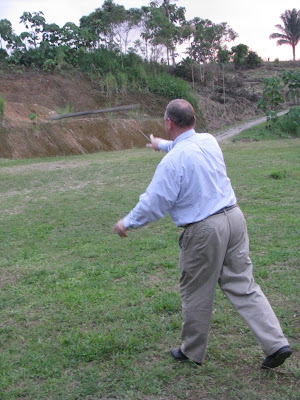Beautiful sunset at the Tsa´chila Village.

Such an interesting culture, we feel we have met new friends. The tatoo looking stripes are for protection. They are painted on using juice from a plant, they go on clear and darken in the sun, they usually last about 7-10 days.


Dancing seems to be a large part of most cultures, again we are dancing with the natives.

Toddlers are kept in this "play pen" while mothers are busy cooking or doing other chores. This protects them from getting into the fire or wandering off.

This may be the original baby swing. The baby is placed in the cloth that is tied to a tree limb which can be bounced or swung.

Traditional dress, the men wear a black and white cloth with the red waist band, symbolic of the snake, the women wear a multi colored cloth symbolic of the rainbow. The women weave these cloths and the weaving is beautiful. He is demonstrating a bird trap.

Trying our hand at throwing a spear. Good thing we can shop for our food because we might get real hungry if we had to hunt for food this way. You know what they say, vegetarian is another name for bad hunter.

Again I fell in love with the children. They are learning the ways of their people, classrooms have been built as part of this project and the children are learning "tsafiqui", their native language.

These leaves are used for cooking, the fish is wrapped in a leaf and placed on the fire to cook. Amazing how native peoples have learned to use the resources available for all their needs.

Tolon-Pele means the mythical tree. This tree is huge and the people appear to worship it. They say there is no other trees like it. They appear to be a spiritual people with a mixture of ancestor worship, nature worship and a belief in a Great Spirit. I found the tree interesting in two ways, 1. It reminided me Avatar and the Home Tree, and 2. I thought of the tree of life in Lehi´s dream.


Sampeling some of the sweet juice.

Dad got in on some of this action!

Extracting the sweet juice from a sugar cane. This seems to be more of a game than work.

The Tsa´chila are known as herbalists and their shamans are believed to have healing powers. They had a pot of various leaves cooking on the fire, in each hole was other leaves, the hot water was poured into the hole, then a hot rock from the fire was placed in the hole. The steam had a pleasant order, they indicated that one would sit with a blanket over them and breath the steam to cure illness. They do seem to have a great knowledge of the jungle plants and their uses.



When the Spanish arrived they brought with them smallpox, many of the indians died,a shaman prayed to the great spirit and the next morning the sun was shining on an achiote bush, the people took the seed pod and removed the berries inside, crushed them and then covered their bodies with the red juice. The death rate decreased and they felt this was an answer from the great spirit. Now the men in the tribe use the juice to color their hair in rememberance. The Spanish called them "los Colorados" because of the red skin. The area is known as Santo Domingo de los Colorados.

Our guide for the tour, the women wear tops for the tourists sake, there is only so much cultural shock one can be expected to deal with. This tribe was described in journals from the 1600´s but it wasn´t until the 1950´s that "civilzation" came to the Santo Domingo area with the building of roads. It was an isolated area because of the high mountains that had to be crossed to get here.

August 3, 2011
Again, following our first day of training we took a trip, this time we visited a Tsa´chila Indian Village. These little side trips are called cultural experiences and are part of what we provide for the teams that come to Ecuador to do projects. This is a village we had heard about and I was so excited to be able to go and see it. I was not disappointed, it was fabulous. The people are trying to preserve their culture and way of life, although it seems a hard way of life to me, so their children will know their roots and be proud of their hearitage. There were about 20,000 Tsa´chilas when the Spanish came, there are now 2,000 in 8 small reservations. Tsa´chila means "true people" or the "true word". Kind of makes me wonder if there are some Book of Mormon roots in their history. They took us through so many different aspects of their daily life, I´ll try to share some of it. I did do some vidios but this post is getting very long so I will post the vidio at a later time.






















































